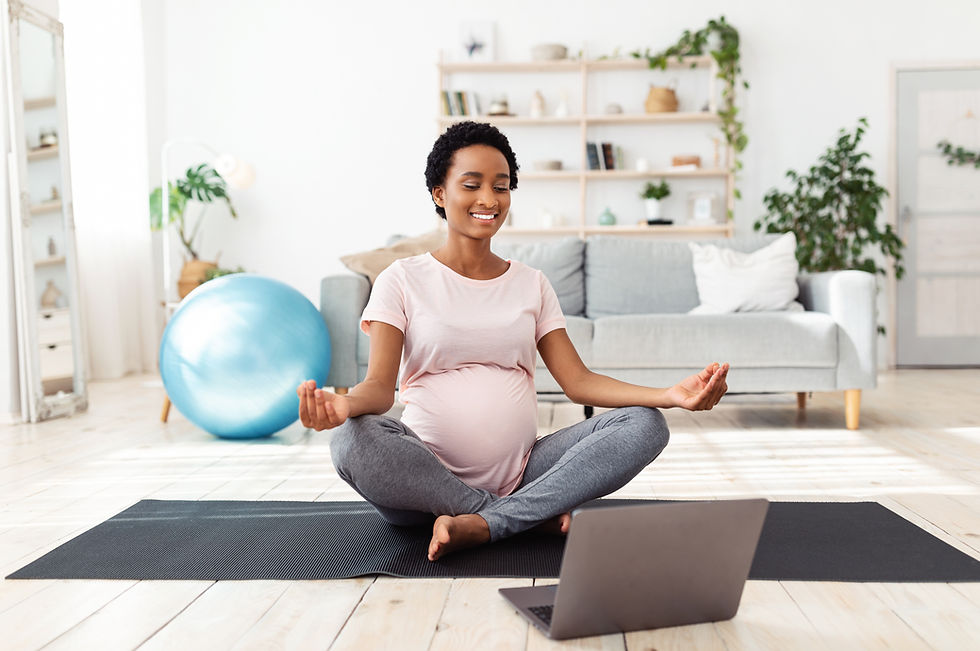Yay! You’re pregnant. How much should you exercise in your first trimester?
- Jul 7, 2023
- 4 min read
Updated: Apr 10, 2024

I remember the mixed emotions and questions that flooded my mind during my first trimester. Should I change my yoga routine? Can I keep up with my workouts? Can exercise harm my baby? If you're feeling the same way, you've come to the right place! In this post, I'll answer all those burning questions and guide you through exercising with confidence during your first trimester.
Understanding the first trimester
The first trimester is a whirlwind of changes, both emotionally and physically. Your body is working hard to create a safe and nurturing environment for your baby. Hormones, like relaxin, are surging through your body, supporting the growth of the placenta and ensuring a healthy pregnancy. You might experience symptoms like fatigue, tender breasts, nausea, and frequent urination – all part of the incredible journey of growing a little human. It's important to listen to your body and give it the rest it needs.
Benefits of exercising in the first trimester
Did you know that moderate exercise can boost the growth rate of your baby and reduce the risk of gestational diabetes? Studies have shown that moderate exercise during pregnancy can have numerous benefits. It can promote healthy fetal growth, reduce the risk of gestational diabetes, boost energy levels, and alleviate pregnancy discomforts. Yoga, in particular, offers additional benefits like decreased risk of preterm labor, lower blood pressure, and improved mental well-being. It's a win-win for both you and your baby!
What to consider when exercising in the first trimester
Before starting or continuing an exercise routine, it's crucial to consult with your healthcare provider to ensure it's safe for you and your baby. They can provide personalized guidance based on your medical history.
Paying attention to your body’s signals throughout your workouts is key. If you feel dizzy, short of breath, experience pain, bleeding, or decreased fetal movement, it's important to stop exercising and seek medical advice.
Now, let's talk about modifying your workouts. It's completely normal if you don't feel up to your usual exercise routine during the first trimester. Your body is already doing an incredible job growing your baby, so take it easy. Consider reducing the intensity, duration, and weights in your workouts. Opt for gentler yoga poses and low-impact exercises that still provide cardiovascular benefits without straining your body.
Google will give you tons of “safe” exercises to try, including yoga. The thing is, safe can mean something completely different to you than to me. This is why it's so vital that you catch the signals that your body gives you. Only you and your body know what is safe and what isn’t. Just think about Beyonce dancing around in heels in a concert with her huge belly or those badass athletes running marathons while pregnant.
Can exercise cause a miscarriage or preterm labor?
Studies have shown that regular exercise does not increase the risk of miscarriage. However, if you have an "inducible cervix" (a cervix that is soft, thin, and starting to dilate) before 37 weeks, it's best to consult with your doctor regarding exercise recommendations.
Can I still do high intensity workouts and power yoga?
If you're feeling good and have no concerning symptoms or conditions, you can continue these routines. Just remember to listen to your body, make modifications as needed, and be mindful of your limits.
Can I start exercising during pregnancy?
Absolutely! If you're cleared by your doctor and have no contraindications, it's a great time to start. Take it slow, gradually increase intensity, and consider working with an instructor for proper guidance and support.
My top 5 tips for exercising in the first trimester
Stay hydrated and wear comfortable clothing: Drink plenty of water before, during, and after your workouts. Dress in comfortable, breathable clothing that allows for movement and temperature regulation.
Don't skip your warm-up and cool-down: Always start with a warm-up to prepare your muscles for exercise and cool down afterward to bring your heart rate back to normal gradually. It's a great way to prevent injuries and promote muscle recovery. Don't skip savasana!
Balance and stability matter: As your body changes, your balance may be affected. Don't be afraid to use support like a wall or chair for stability. Modify movements as needed to maintain proper form and prevent any accidents. Stay at 70% of your edge when exercising and stretching to prevent injuries.
Prioritize pelvic floor and core strength: A strong core and pelvic floor are crucial during pregnancy. Try exercises that target your pelvic floor muscles and engage your deep core muscles.
Take time to relax and breathe: Pregnancy is a time of immense changes, both physically and emotionally. Don't forget to incorporate relaxation and mindfulness practices into your exercise routine. Deep breathing, meditation, and gentle stretching can do wonders for reducing stress and promoting overall well-being.
Learn 5 key yoga poses to maintain or correct your posture and prevent aches and pains during pregnancy from carrying your ever-growing baby.

Remember, every pregnancy is unique, so it's crucial to pay attention to your body’s queues and seek professional guidance when needed. Celebrate this special time and embrace the many benefits of maintaining a safe and appropriate exercise and yoga routine throughout your pregnancy journey! 💪❤️
.png)

Comments